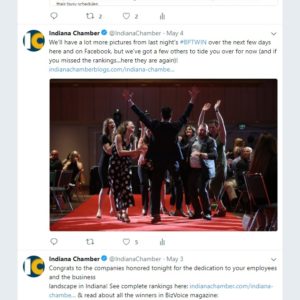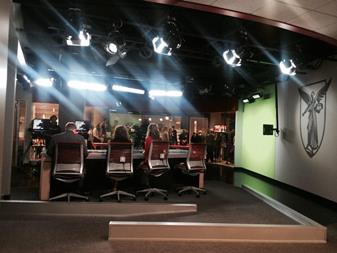
It was the first time we’ve broadcast live from that event – meaning you could be part of the action, even if you were watching from home!
If you follow us on Twitter, you’re the first to see our posts and news regarding legislative priorities and policy matters important to the Indiana business community.
Earlier this year, for example, you might have been following along as Indiana Chamber President and CEO Kevin Brinegar tweeted from one of Indiana House Speaker Brian Bosma’s “Tweet Seats” during the Governor’s annual State of the State address.
On Instagram, you’ll get a glimpse of life behind the scenes here at the Indiana Chamber, from learning more about our new employees to how we celebrate the holidays, give back to the community and relax together as a company.

LinkedIn is a great way to learn about our many conferences and seminars, awards and updates and so much more.
You can also find us on YouTube with a variety of videos. Overall, social media is a great way to keep in touch with the Indiana Chamber and to receive breaking updates about the state’s business landscape.
Member news: If you’re looking for broader visibility for your company news and updates, submit your press releases through our Member Press Release submission form. Not only are those archived on our web site, but we regularly highlight this news and information to our 18,400+ Twitter followers and over 2,400 Facebook fans.Our presence on social media is also one of the benefits of membership with the Indiana Chamber. Here are some of the various member-related features you can find across our feeds:
- Member Spotlight: We also shine the light on Indiana Chamber member companies through their own narrative with the Member Spotlight feature.
- And we’re regularly interacting with Indiana Chamber member company accounts on social media, with this blog and the EchoChamber podcast, sharing conversations, posts and updates about what’s new in a number of companies and industries around the state.
But the best way for you to find out what we have to offer via social media is for you to follow, like or subscribe (if you don’t already) to our accounts.
You can also contact Communications and PR Manager Charlee Beasor at (317) 264-7543 if you have any questions or need more information about our social media presence and how your company can follow along or join in the conversation.


 Today’s college students are immersed into social media while American corporations are looking for employees with such skills after investing heavily into digital marketing.
Today’s college students are immersed into social media while American corporations are looking for employees with such skills after investing heavily into digital marketing. Ball State’s reputation for offering top shelf communications curricula is impressive — especially when it comes to
Ball State’s reputation for offering top shelf communications curricula is impressive — especially when it comes to  I’ve tried, unsuccessfully for the most part, to reduce the stranglehold of email on my business life. I’ve followed some of the guidelines — only check at certain times of the day, create folders for next steps, etc. — but that doesn’t seem to stop the unending flow.
I’ve tried, unsuccessfully for the most part, to reduce the stranglehold of email on my business life. I’ve followed some of the guidelines — only check at certain times of the day, create folders for next steps, etc. — but that doesn’t seem to stop the unending flow. At the Chamber, we've recently undergone a renovation of sorts, which has featured a good deal of fall cleaning.
At the Chamber, we've recently undergone a renovation of sorts, which has featured a good deal of fall cleaning.
 From the "sad but true" category,
From the "sad but true" category,  PR Daily has
PR Daily has